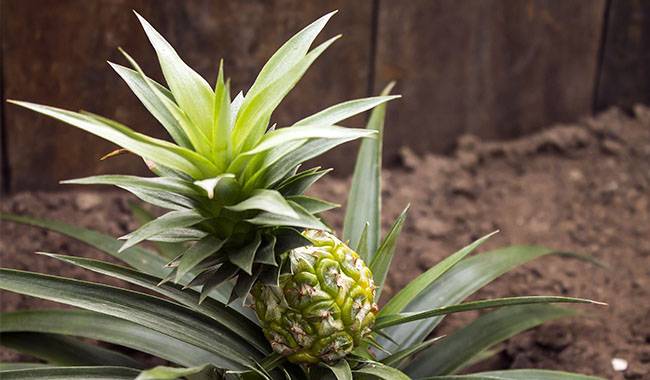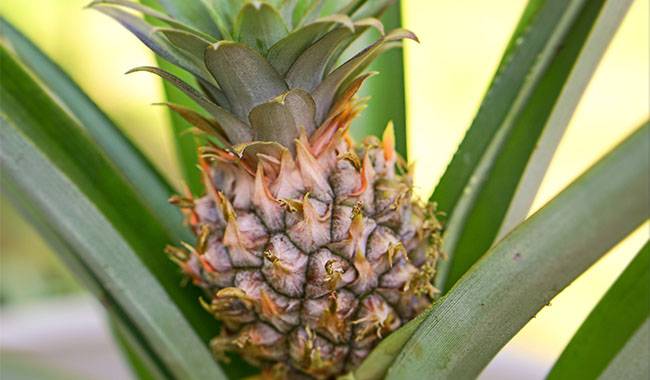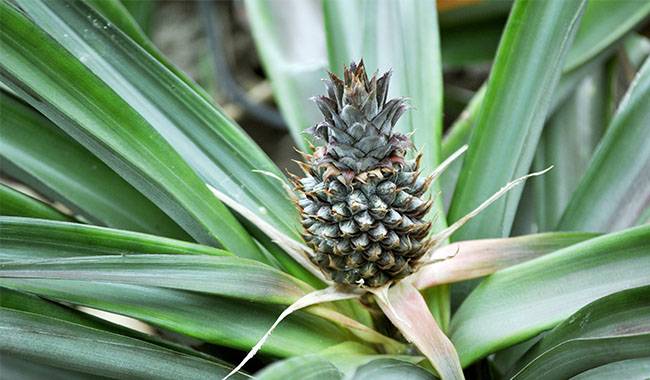
The king of indoor fruits and everyone’s favorite, the pineapple, is grown because its fruit is small but special. The ornamental value of the hard, thorny leaves is equally important. This plant is typical of the bromeliad family in appearance and has a simple character. In the living room, it is easy to meet the pineapple’s growth requirements. If it starts to wilt, its leaves yellow and die, and it stops being a beautiful pineapple bush and looks like a twig, it’s time to sound the alarm. And look for the cause of the pineapple’s illness. You will learn how to grow pineapple plants in ThumbGarden’s article.
PINEAPPLE PLANT DESCRIPTION
Pineapple (Ananas comosus) is again often found on the shelves of fruit stores. While many houseplants require extremely stringent conditions to bloom and fruit, Pineapple rejoices in steady warmth and can be easily created indoors. It is one of the most adapted bromeliads for indoor environments, but it is sensitive to the quality of care like its brothers.
Although initially attracted to the indoor pineapple for its delicious and very pretty scapes topped with a ring of leaves, the decorative green color of this plant should not be underestimated. This evergreen bromeliad has handsome leaves that are arranged in asymmetrical but very pretty rosettes that possess a more resilient green color. The dangerous spikes on the edges of the leaves are barely visible, so it’s easy to make mistakes and forget about them when handling the plant.
The linear, meadow-like leaves, up to 40 inches (1 meter) long and only 1 inch (2.5 cm) wide, are grayish, almost silvery in color. The edges are often heavily decorated with wide pale yellow stripes, which make them even more attractive. However, both the plain pineapple and the mottled form always look magnificent.
Pineapples are quite predictable in their flowering and fruiting. They produce a tall inflorescence in their second or third year with hundreds of tiny, very pretty flowers. In the same year, from May to August, their distinctive fruits begin to ripen, their ripeness indicated by the changing color and fluidity of the top rosette leaves.
PINEAPPLE MISTAKES IN CARE
Among the indoor bromeliads, the pineapple is the only non-vegetative plant. It rarely gets sick, but pineapple problems are still typical for homes. The cause of pineapple growth difficulties is almost always a lapse in care. After all, the conditions are simple: you need to keep the temperature from dropping below 60 °F (16°C), lower it slightly in winter, and provide heat in summer. It is a sun-loving plant, suitable only for the windowsill.
Therefore, most of the time, pineapples get sick because of a completely different kind of blunder. The following reasons can cause this.
- Insufficient watering during periods of vigorous growth, especially when the substrate is completely dry and often dries out.
- Watering with cold water.
- Over-watering, causing the substrate to stagnate and not dry out at all.
- Fertilizing too often.
- Complete absence of nutrients.
- Extremely dry air near the heater, or lack of fresh air in the hot summer months.
- Sudden temperature fluctuations while drying.
- Soiled leaves, dust accumulation, crusting, and mold formation on the top layer of the substrate.
- Excessively heavy substrate.
- Lack of drainage system.
Pineapples in the average living room are sometimes “decorated” with dried leaf tips. If this happens, the problem is probably not dry air, but a combination of watering, fertilizing and maintenance, combined with too dry air.
MAJOR DISEASES OF PINEAPPLES GROWN INDOORS

However, some problems with pineapples are caused by pests and diseases. They always appear due to mistakes in watering, feeding, and hygiene. If there are signs of pests and diseases, quarantine the pineapple immediately.
If you find a sticky layer of honeydew on the plant, do not hesitate to carry out the first treatment – wash the leaves with simple soapy water. Even if you can’t get rid of the problem in this way, this simple measure will slow down the spread of the pest and help save the pineapple.
Unlike in most crops, in pineapples, anthracnose, various rots, spot diseases, and phylloxera are always “side effects” that make the plant vulnerable due to improper care.
Pineapples respond very painfully to watering the soil. A few too many waterings are enough to cause problems. Rot is usually not recognized from stunted growth but from the oldest leaves, which first soften and become covered with black spots at the base of the plant. The more severe the problem, the farther along the base of the rosette, the more visible it becomes.
Rotting problems can be corrected by changing care, drying the soil, or emergency transplanting.
If overwatering has not become a permanent problem and the watering is quickly corrected, but the plant still shows signs of rot, it is worthwhile to analyze the quality of the fertilizer. Extreme vulnerability in pineapples may be caused by excessive nitrogen and over-fertilization, which in pineapples do not lead to vigorous growth, but to extreme vulnerability.
PESTS OF PINEAPPLES GROWN INDOORS

If there are signs that pineapple is sick, the first thing to suspect is damage from scabies, which love this plant. The black, palmate, comb-like, and more “narrowly specialized” scales of pineapples spread surprisingly quickly on the plant’s leaves, causing loss of ornamental interest. While they are relatively slow on other plants, they are very fast on pineapples. It manifests itself by yellowing the leaves and rapid shriveling, causing the plant to wilt before its eyes.
Pineapples have fairly dense leaves that will allow you to get to the root of the problem. A simple rinse will not work. The most reliable option is to remove all pests by hand, using a stiff cloth soaked in soapy water or alcohol (a soft sponge or cotton ball won’t cope and will stick to the thorns). Then apply the insecticide treatment at the concentration recommended by the manufacturer.
If the plant stops growing and the leaves dry out quickly and are covered with traces of sooty fungus without any visible spots. You should suspect an entirely different pest, i.e., a bug. Although the sooty fungus is not noticeable at first, it becomes a continuous film as the infestation progresses. This is because young pineapples die quickly; the death process is slower in older pineapples.
Common and bristle-toothed mealybugs are common on pineapples and affect the above-ground parts of the plant. More dangerous is the rootworm, which attacks the root system, especially the root neck, causing rapid plant decay.
It is important to combat these worms quickly and from the root. When infested with whiteflies and stubby worms, the first step (besides isolation) is to wash the plant with soapy water and then gently wipe the leaves with a cloth soaked in alcohol. But in any case, you cannot afford not to follow up with an insecticide treatment.
However, rootworm problems must be dealt with vigorously: watering should be limited to a minimum, the substrate should be thoroughly dried, and a solution of systemic insecticide should be added to the water at the time of watering. Plants should be monitored, and treatments should be repeated as soon as signs of residual insects on the roots are detected. If several such treatments do not help, it is best to destroy the plant.
Leaving pineapples in high temperatures, near heaters, not watered regularly, and not keeping the leaves clean can easily lead to the plant being infested with another pest. Red spider mites spread quickly on pineapples and multiply rapidly. They are easily found on hard leaves as the fine spider webs are clearly visible. If control is not started in time, the leaves will slowly turn yellow and fall off, more often than not without drying out.
In the early stages, spider mites can also be controlled with a simple sanitary spray to create a hostile environment for the insects. If the infestation is severe, you should first wash it with a soap solution, and if that does not help, you must spray it with an insecticide.
Pineapples often suffer from the slow movement of the most common household pest, the orchid aphid, which is easily found on the upper side of the leaves.
This pest on pineapples can only be controlled by insecticide treatment, but it is important to start early. To prevent pests that cannot be treated with chemicals, it is best not to neglect the rule of regular leaf inspection.
NATURAL DEATH OF THE MOTHER PINEAPPLE PLANT
As with all bromeliads, the rosette of the mother plant that dies after the pineapple has flowered and fruited is replaced by a new plant. The appearance of root buds is the first indication that pineapple has died from fairly natural causes.
Offspring rosettes usually only separate when grown to at least 2 inches (5 cm) and formed their complete root system. But sometimes the result of a purchase is disappointing: a pineapple that has been picked by mistake, using stimulants to force it to flower faster, but which has not managed to produce offspring, dies after the fruit has ripened. However, do not be too disappointed. The plant can reproduce itself by adopting a bud, thus making it a strong plant.



